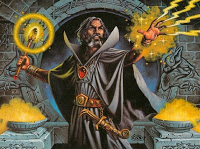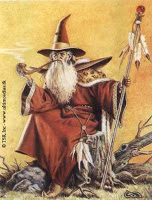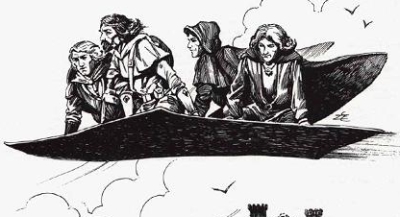In the comments of my previous post on “advancing the timeline” in Greyhawk, commenter scottz made a very interesting point:
“Characters/NPC’s are canon ‘mountpoints’ as much as maps or gazetteers are, IMHO.”
I take this to mean that, if one is running a campaign in a premade setting such as Greyhawk or the Forgotten Realms, one expects to interact with, or at least hear about third-hand, some of the notable non-player-characters that have become associated with that setting over the years.
I agree wholeheartedly with scottz on this point; notable NPCs from the
setting are as much a part of its ambiance as its notable dungeons and
the names of its kingdoms.
In Greyhawk, this would mean the likes of Melf, Tenser, Mordenkainen, Sir Robilar, and so forth. In the Realms, the quintessential NPC is of course Elminster, but being taken on as an agent of the Harpers to thwart the machinations of the Cult of the Dragon would certainly qualify as well.
 Now that I’m going to be restarting my own Greyhawk campaign, my thoughts naturally turn to how I can make it an exciting and enjoyable experience, and the role of these sorts of notable NPCs naturally springs to mind.
Now that I’m going to be restarting my own Greyhawk campaign, my thoughts naturally turn to how I can make it an exciting and enjoyable experience, and the role of these sorts of notable NPCs naturally springs to mind.
I’ve actually done this in the past with great success with some of the minor characters encountered in the Gord the Rogue books (and who are known from GH lore as well) such as Biff the halfling, who is a henchman of Melf, and it was a complete blast.
But I wonder how many DMs out there do this as well? Outside of
published modules (because, naturally, anyone who runs the Temple of
Elemental Evil is going to by definition have their PCs encounter
notables such as Burne and Rufus), how many people who run Greyhawk or
other premade settings also make a point of using some of the notable
non-player-characters when they do so?











I've always liked to leave at least little tidbits of information regarding these iconic characters. They may not necessarily figure into the plot (if they do, I try to make sure they only appear in one out of VERY MANY campaigns or else VERY INFREQUENTLY) but many of them are so famous it would almost be hard not to hear about them.
I think it's a waste to write them out completely, but it is likewise not the best course of action to overuse them because they will begin to overshadow the developments of the PCs. This is an experience I think a lot of players had under less-than-stellar DMs in the Realms, leading to Elminsteritis and a hatred of such figures.
Agreed, Idabrius. Over-use is a real problem with such figures.
Mr. B, you raise an interesting thought: what's the difference between Mordenkainen and Rufus, aside from many levels of experience?
Is it a question of influence? scope of influence? power to cause change?
I mention this, because I never thought of Burne and Rufus as being a burden, yet I'd love to read about campaigns that completely cut out the high level notables…
I can't say a great deal but…yeah, I do occasionally stir the pot (or just stir the curiosity of my players) with NPC encounters.
When you consider the size of the premade settings, a meeting with one of the uber-characters would be quite a coincidence — at low level, anyway. I liked your idea of the interaction with a minor character, though. Certainly, anyone playing in a Marvel Superheroes world would want to meet Spider-Man at some point, so I suppose it's inevitable that Mordenkainen and others get brought into play.
I think they are more useful as backstory elements or possibly as a source of information to advance a plotline. Beyond that they outshine the PCs. How could a PC compare with Drizz't?
Lastly, since you've run so many prior campaigns there … why not turn some of your old PCs into Tenser-like NPCs? Sure, they may not have PHB name recognition, but you could certainly weave them into your story seamlessly, knowing every aspect of their story.
In cape-and-sword games, interacting with historical figures is part of the genre.
I think that speaks to the whole point of this post, BV, thanks. Is that sort of interaction something that is necessarily limited to the "sword and cape genre" (a term I'd never heard before)? Or can it be successfully applied beyond that?
scottz: I think one of the big differences between someone like Mordenkainen and someone like Rufus is one of notoriety.
I mean, anyone who plays D&D is likely to have at least heard the name Mordenkainen, and one doesn't need to be a real dyed-in-the-wool Greyhawkian to know something about him.
Rufus, on the other hand, is somewhat more obscure. While meeting him (or Burne, or Otis) is going to be a treat to someone who is a genuine Flanaessophile, the experience would be lost on someone who had only a casual knowledge of the setting.
Keeping the PHB recognition NPCs there, but in the background, is in my view one of the distinct pleasures of running games in Greyhawk. Somehow there is more of a sense of the game and the setting merging via the attachment of those lofty names to certain spells. This is part of the distinct flavour of ad&d which I loved as a kid- that, by playing a magic-user in Greyhawk who knew one of bigby's or Rary's or Mordenkainen's spells, you were only three parts removed from Gary's game. Always loved that…
I think use of renowned NPCs can depend on the experience of the players. My GH campaigns consist of many longtime GH fans who have already been thru many of the published mods and seen me use all the main movers and shakers. This of course runs into the problem that they aren't impressed by them as much anymore so I tend to stay away from the big NPCs now. If you want to break in new players to a setting and be sure they have a lasting impression, IMO you must use these NPCs.
I don't run a GH game, but if memory serves I believe Tenser and Robilar both had keeps a short distance from Greyhawk, and a couple of lesser known notables actually lived within the walls. Someone, I think it was Digby, owned a bar within Greyhawk as well. Given all that, I would expect these people would be fairly visible around town on occassion, and more renowned individuals would be seen as well when they come visiting.
I have always tried to include them. Depending upon the level of the PCs involved though I use "include" in a very broad sense.
Low level PCs might hear a rumor or see the aftermath of someone notable's actions. Or meet a hireling of a major NPC and be drafted for work. The higher the level of the PCs the higher the chance of actually meeting this notaries in person.
As I prefer running games for groups who don't have Greyhawk experience I also enjoy getting players to interact with these iconic persons. It gives me great pleasure to hear my players retell how they were taught Otto's Irresistible Dance or how they were present when a mage cast Melf's acid arrow to a polymorphed Melf traveling incognito…
What I always try to avoid is to drag a story into cliche mode when these major NPCs overshadow the campaign and the usual questions arise (Why doesn't
Mordenkeinen go in there himself? What's he doing while we are out saving the world etc…)
Back when I was DMing 2E in the early '90s, my players saw Drizzt as an aspirational figure rather than a roadblock and all of the unmarried NPC femme fatales (Alustriel, Myrmeen Lhal, etc.) as potential love interests. If you get hung up on canon and don't allow the PCs to impact the NPCs in return, then I can easily see hating famous NPCs. If, on the other hand, you allow your wife's PC to romance and reform infamous rogue Elaith Craulnober, then it's fun for everyone.
From my Golarion campaign, Ferd of Welcome Wench Inn fame has come a Long way!
Set' (of the Paizo board) came up with the original.
Dwarven Extra Dark Stout might have the consistency of thick molasses and be potent enough to make one's eyes water. While originating from the Dwarves, both humans and halflings have been know to make a variation of this Stout. Traditionally, a light dollop is added to 'lesser' beer, ale or whiskey, to make it a stronger beverage, with the clump of darker solid/liquid sinking slowly into the weaker beverage and dissolving. A more 'manly' practice is to dip one's finger into a small dish of the extra stout, rub it on one's teeth and then 'chase' it with ale. Dwarves who regularly engage in this practice will have a semi permanant dark stain on their gums, lips and/or finger. And the heady breath of a horse on a hot high summer day.
…
Battleragers of Clangaddin usually carry wineskins containing a vile concoction of fermented mountain goat's milk, distilled deep mold and questiionable herbs loosely called "gutshaker" or "gutsquisher." Battlerages, other Dwarves and some Halflings with very high constitutions, and Black Dragons are the only creatures known to drink gutshaker without becoming utterly and violently ill.
This substance has been known to "curl the toes" and "blur the wits" of a normal Dwarf. Taking a few swigs of this toxic drink has the side benefit of rendering Battleragers immune to Drow sleep poison, and the perfect mental state that a Battlerager seeks to achieve; that is the improbability of any clear thought process whatsoever.
Heh, posted the wrong aperitifs!
Here's the Ferd brew.
In 1371 a local brewery owner named Furnok of Ferdshire disappeared mysteriously, and, a year later, when the a very large cask of rum was opened, he was found to have fallen into it, and yet his heirs went on and sold the rum anyway (after fishing him out of it of course…). Nearly a full century later after this supposedly happened, people still sell rum that's supposed to be from that batch, or at least from that same cask, under the name 'Furnok's Final Rest in Ferd' or something similar.